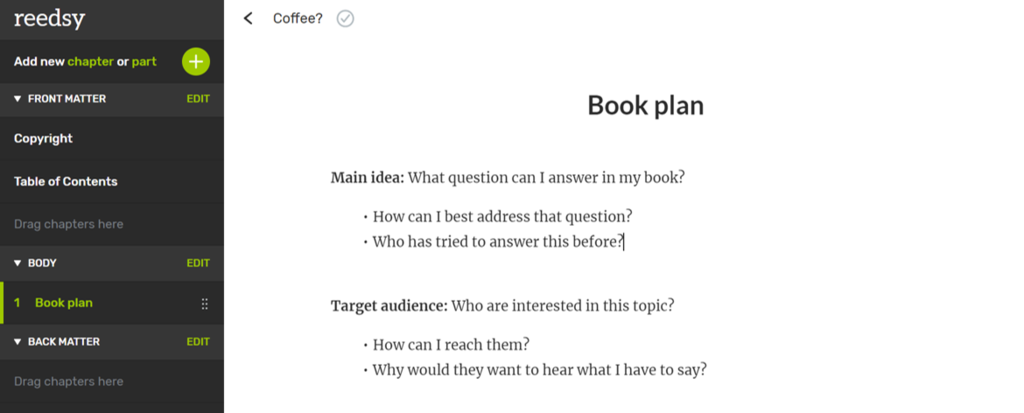Guides • Perfecting your Craft
Last updated on Apr 23, 2021
How to Write a Nonfiction Book in 6 Steps
About the author
Reedsy's editorial team is a diverse group of industry experts devoted to helping authors write and publish beautiful books.
More about the Reedsy Editorial Team →Savannah Cordova
Savannah is a senior editor with Reedsy and a published writer whose work has appeared on Slate, Kirkus, and BookTrib. Her short fiction has appeared in the Owl Canyon Press anthology, "No Bars and a Dead Battery".
View profile →Writing a nonfiction book is a good way to share your story, impart your wisdom, or even build your business. And while you may not have thought about becoming an author before, it’s not as far-fetched a goal as you might think. In this post, we'll show you a simple process for becoming a nonfiction author. Hold onto that book idea of yours, and let’s see how we can turn it into something that readers will love.
How to write a nonfiction book:
1. Determine what problem your book will solve
When you start out, your idea is likely to be nebulous or vague, e.g. “It’s a self-help book for new parents.” Before you put pen to paper, you need to crystallize and tighten your original idea, as well as think about your target audience and how to reach readers. Using that information and the tips below, you can validate your book idea, find a sense of direction in your writing, and prepare for when you try to get a book deal, if you want to traditionally publish.

FREE RESOURCE
Book Proposal Template
Craft a professional pitch for your nonfiction book with our handy template.
Nail down your book idea
A key part of figuring out how to write a nonfiction book is being able to answer the three important "W" questions:
- What is it about?
- Why does it matter, and why should you write it?
- Who will want to read it — or rather, who are your ideal readers?
Once you can answer these questions, you can fill in the blanks below:
[The who] will read my book about [the what] because [the why].
For example: "CEOs will read my book about workplace culture because it offers insights into the practices of the top ten companies voted 'best places' to work in the USA."
Being able to distill your book down in this way is a good sign you have a solid concept, and that your book will ultimately be marketable. If you can’t answer one of those questions, it may be time to return to the drawing board and tighten up your book’s main idea.
Research your topic
Once you’ve pinned down your idea, you’ll want to dig a bit into the topic or the nonfiction genre of your book to find the leads to develop this idea. Research is very important, and it can come in many shapes and sizes depending on the project. Here are a few of the different types of research that are suitable for certain genres.
💭 If you’re writing a memoir
We’ve got a whole guide on writing memoirs with more research tips, but if there’s one thing we recommend you do, it’s to interview yourself. Ask yourself questions that strangers might ask you. A simple interview like this can help you reassess your memories and pull out the important bits of your story. (And of course, you can always have someone else interview you too!)
🔧 If you’re writing a how-to
Your research may involve collecting all sorts of existing material on the subject — such as blog posts and previously published essays. You might want to test some of the methods out in order to home in on the most effective instructions.
☯ If you’re writing self-help
When writing a book about helping yourself, you might want to reach out to experts, such as psychologists and inspirational speakers, who can provide more evidence and insight to what you already know. If you're an expert yourself, you can interview yourself as you would for a memoir. It also doesn’t hurt to check out some of the best self-help books for inspiration!

GET ACCOUNTABILITY
Meet writing coaches on Reedsy
Industry insiders can help you hone your craft, finish your draft, and get published.
⏳ If you’re writing a history or biography
You’ll be gathering resources in libraries and archives, looking at primary and secondary sources on the matter. And if you’re writing about someone who’s still alive, you’ll probably need access to said person, or at least have their consent before forging on with the research.
💼 If you’re writing a business book
This requires a lot of understanding of the market that you’re writing about, be it the one concerning stocks or houseplants (see more of what we mean in our guide on how to write an ebook). You have to find out who might be interested in the products you're talking about, what their habits are like, where they usually go to for advice on matters related to the product — the list goes on. If you really want to dive into this route, perhaps this free course of ours can be of some help…
Free course: How to write a business book
How can writing a book revolutionize your business? Only one way to find out.
2. Outline your book with a logical structure
Like fiction, where story structure can make or break a narrative, nonfiction relies on the reader being able to follow the writer’s leaps of logic. Since nonfiction is all about utility, structure is of the utmost importance in guiding the reader toward the information they need. You want your structure to be coherent but also gripping, so that readers want to read on and remember what they’ve read.

Typically, if your book is about a process, or is a how-to, a linear structure makes sense. To make things more exciting for readers, you can also choose to disrupt the linear flow and follow a list or essay structure. Not sure what these structures are? Head on to our guide on how to outline a nonfiction book to find the answers (and more planning tips).
3. Choose a style guide to remain consistent
Before you start writing, pick a style guide to follow throughout your book. What’s a style guide, you ask? It’s a set of guidelines to help keep your writing consistent. If you’ve worked with both US English and UK English, you might notice that certain things get spelled differently, i.e. ‘color’ versus ‘colour’. You should choose the variation that best suits your target audience, depending on where they’re based. A manual of style would help ensure you keep to one of those versions, along with some other details like whether you use the Oxford or serial comma, single or double quotation marks, or how to list your references. A popular guide that you might find useful is the Chicago Manual of Style.
Why do things like this matter? Firstly, a proper guide matters to a nonfiction book because this book is supposed to be factual and accurate. Whether you’re writing popular self-help or more academic pieces, referencing will be a crucial part of your credibility, so you’ll want to nail it from the moment you start. Secondly, being consistent as you write will only help you in the editing process, preventing you from having to correct the same mistakes over and over again.
4. Blast through your messy first draft
Now the planning’s out of the way, there’s nowhere left to run: it’s time to actually sit down and write your first draft. Luckily, we've got plenty of tips for writing to help you out!
Use storytelling techniques
Almost anything is more comprehensible and memorable when told as a story. Stories are easier to follow along, they get readers invested in the topic and curious about what happens next, and they tend to be more memorable than just hard facts. Which is why you should think about the stories that you can tell through your nonfiction book, and how to get the most out of them.
So when you use anecdotal evidence, think about the person (a.k.a. character) involved, what their motivations and feelings are. How can those motives and sensations be linked to your main point? If you can, the fact that you’re sharing will be that much more meaningful to the reader because they've associated it with a story. Of course, you shouldn’t embellish facts and end up in the realm of fiction, but an eye for narrative detail is a big asset for a nonfiction author.
Hear it from another author: Harry Freedman shared his process with us in this Reedsy Live!
Include dialogue
Continuing on from the previous point, there’s no reason why you shouldn’t use dialogue in your nonfiction writing. It’s a given that you’d use it in creative nonfiction, but it’s also a great way to break up dense texts and add a human voice to your book. If you have a transcript or a record of a direct quote, you can write it as dialogue. If not, feel free to refer to what was being said as something you’ve been told, rather than something someone said. The difference is subtle (as you can see in the example below), but either way, including conversations make the writing more accessible and interesting to read.
“I bought a lot of ice cream that week where there was a heatwave,” Joe said.
Hot weather makes people crave ice cream — I remember my neighbor, Joe, stocking up in preparation for a heatwave.
Of course, it goes without saying that in academic writing this might not be the most conventional or professional option. But if you have a clear recording of the conversation, and you see the value of including it in your book, then you can do it. Note, however, that the formatting for dialogues in academic writing especially may be different from the ones you see in fiction writing (this is why we cannot emphasize enough the need to find an appropriate editor).
Avoid jargon
This just might be the most important piece of advice we can give you: keep your use of jargon and complicated language to a minimum. This does not mean that you have to cut away every expert term you have in your vocabulary, it just means you should use them mindfully. Remember that you may be writing for a quite a big audience, many of whom might not know what you’re talking about. Not only will they need you to explain the term when you first introduce it, they’ll also be less likely to remember these terms if they’ve only just met them.
As such, you want to minimize the use of jargon in your writing. If there’s a simpler way to express something, use it. It might feel like you’re killing story elements you love, but it will most likely be appreciated by your readers.If you must use specialist vocab, be sure to define it and add refreshers where necessary.
Have a writing schedule
Our final tip is one for your process: create a writing schedule for yourself, whichever fits your own timetable and writing habits the most. Perhaps you have a day job and work best when you have a specific time to write at the end of the day. Or maybe you work better with a monthly goal of finishing certain sections and chapters in mind. Either way, setting out time to write regularly will help you progress and keep you from losing motivation.
5. Revise your manuscript and check your facts
If you think learning how to write a nonfiction book is all about the actual writing, you’re forgetting another crucial dimension of the book business: editing. Most manuscripts go through several rounds of revisions before they reach their final form, and the first round should always be a self-edit. So don’t hold back: it’s time for you to ruthlessly edit your book. Here are some of our best tips for you.
Double-check your facts
It should go without saying, but this is probably the most important part of editing your nonfiction book. Whenever you refer to a fact, a historical event, or an argument that another academic has previously made, you have to make sure that it’s accurate. On top of that, you’ll have to add a footnote and reference at the end, listing your sources. You don’t want to be sharing false facts or accused of paraphrasing others’ works!
As such, combing through and checking your facts is essential. It can be quite a tedious task, and you can never be too careful, so having a second pair of eyes on your manuscript is always a good idea.
Hire an expert nonfiction editor
Hilary D.
Available to hire
Editor with 20+ years experience in TTRPGs, genre fiction, and academic writing. Specialties in history, sci-fi, romance, and LGBTQ fiction.
Jamie T.
Available to hire
Experienced copy editor and proofreader who has enhanced hundreds of novels, academic works, textbooks, viewbooks, art books, and more.
Amy B.
Available to hire
Desk Editor with 5+ years in the industry, currently at Pan Macmillan. Send me a message - I’m happy to chat and see if I’m right for you!
Cut down on excessive information
While we’re on the topic of facts, let’s talk about being overly informative. Can a book that’s supposed to educate ever be provide too much information? Turns out too much of anything can be bad.
Everything in your book should link back to the main problem that you’re addressing. Sometimes it’s tempting to drop in a fun fact or anecdote that you think readers might find entertaining, but it’s important to balance that with the coherence of your book. So as you reread your first draft, think about the purpose behind the pieces of information you lay out, and remove those that don’t aid in answering the main question of your book.
Shorten your sentences
The style guide you picked at the beginning will probably have you covered in terms of punctuation and grammar. What it can’t cover is your sentence length. Most sentences in first drafts err on the longer side — we tend to use more conjunctions than necessary to connect phrases and ideas that are interlinked. However, it’s often easier for readers to take in the details bit by bit.
Aim for 20-30 words sentences, which should max out at about two lines in the standard Times New Roman, 12-point font. Anything longer than 50 words should be avoided as much as possible.
Looking for more tips to refine your nonfiction writing? Reedsy editor Jenn Lien shared plenty in this seminar!
6. Choose to publish traditionally or independently
Self-edits all done? That means you’re ready for the next steps of your publishing journey. The next question to ask yourself is how you’ll be putting this book of yours into the world: will it be through a publisher, or will you produce the book independently? There’s a lot to consider when debating the pros and cons of traditional and self-publishing, but as a nonfiction writer, you might find doing it yourself beneficial, because:
- Publishing is much faster without having to go through agents and publishers;
- You probably have or are building an online presence already and can use that to effectively get your book out there;
- You get most of the royalties.
That said, we’ll share some tips to get you ready for either pathway below. And if you’re still on the fence about the next steps, maybe this little quiz can help you out!
✅
Is self-publishing or traditional publishing right for you?
Takes one minute!
Self-publishing
If you’ve decided to become an indie author, here are some things you might want to do once you finish your manuscript. (Remember that although you’re self-publishing, you won’t have to do everything by yourself! Professional help is at hand.)
✍ Hire an editor (if you haven’t already). At the risk of sounding like a broken record, we can’t recommend hiring a professional editor enough. A fresh perspective will always help when it comes to the nitty gritty details.
🎨 Work with a professional cover designer. In the digital age, the decision to buy a book is arguably more heavily influenced by the appeal of the cover — it’s the thumbnails on Amazon that do much of the work! Artistic book covers like these are guaranteed to catch the eye of browsers, which is why you should definitely work with a designer.
🌐 Get to know Amazon. We know, its influence on our lives is uncanny, but there’s hardly a better place to reach your audience than Amazon. From printing the books to promoting it, there are all the tools you need on this platform to achieve self-publishing success. This guide on Amazon self-publishing will shed some light on how that can be done.
Traditional publishing
Going down the traditional route means that the publisher will take care of most areas of finishing up the product, from the edit to cover design. However, to get to that point, you’ll need to follow some pretty standard steps.
📬 Query an agent. Most large publishers don’t accept unsolicited submissions from authors, meaning they require representation from a literary agent. Some resources we have for those looking to query are:
- How to Write a Nonfiction Query Letter (blog post)
- The Best Nonfiction Literary Agents to Submit to (directory)
📖 Submit a book proposal. Together with an agent, you’ll have to pitch a publisher with a book proposal. This proposal includes your book’s synopsis, its target audience and competitive titles, as well as a sample of one or two of the chapters. So while you don’t need a complete manuscript before you submit, a rough draft will no doubt be helpful. For a bit more detail on the process, check out our free course on how to submit a nonfiction proposal.
Free course: How to submit a book proposal
Get publishers excited about your nonfiction book in this 10-day online course.
Now that you know how to write a nonfiction book, the publishing world is your oyster! Whatever path you take, we wish you the best of luck. And if you do decide to publish, we can’t wait to see what you’ve created.






1 response
David Irvine says:
05/12/2019 – 16:58
I self-published all my books for free using the Amazon KDP software. It was a bit of a high learning curve but worth the time and effort. You can also create a really nice front cover using their cover creator. Anyway, nice write up with plenty of good tips for writers seeking to get published.